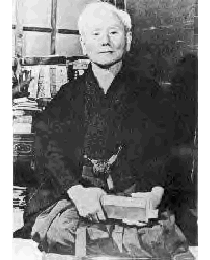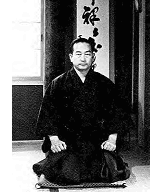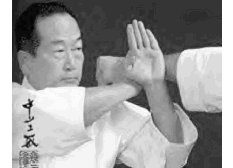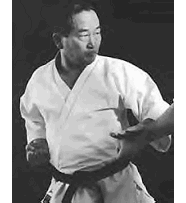|
Brief History of Shotokan Karate
 Karate was introduced to Japan in 1922 by an Okinawan schoolteacher by the name of Gichin Funakoshi. Gichin Funakoshi is widely considered as the "father" of modern karate. He was born in Okinawa in 1868 and learnt karate from two highly respected Okinawan masters of the art, Yasutsune (Ankoh) Itosu and Yasutsune (Anko) Azato. Funakoshi modified the art, taking inspiration from traditional Japanese budo styles (kendo, judo, etc) and emphasised the philosophical aspects. It was this new karate-do that he took to the Japan and was the first expert to introduce the art to the mainland. In 1916 he gave a demonstration to the Butokuden in Kyoto, Japan, which at that time was the official centre of all martial arts. On March 6, 1921, the Crown Prince, who was later to become the Emperor of Japan, visited Okinawa and Master Funakoshi was once again asked to demonstrate karate. In the early spring of 1922 Master Funakoshi travelled to Tokyo to present his art at the First National Athletic exhibition in Tokyo organized by the Ministry of Education. Karate was introduced to Japan in 1922 by an Okinawan schoolteacher by the name of Gichin Funakoshi. Gichin Funakoshi is widely considered as the "father" of modern karate. He was born in Okinawa in 1868 and learnt karate from two highly respected Okinawan masters of the art, Yasutsune (Ankoh) Itosu and Yasutsune (Anko) Azato. Funakoshi modified the art, taking inspiration from traditional Japanese budo styles (kendo, judo, etc) and emphasised the philosophical aspects. It was this new karate-do that he took to the Japan and was the first expert to introduce the art to the mainland. In 1916 he gave a demonstration to the Butokuden in Kyoto, Japan, which at that time was the official centre of all martial arts. On March 6, 1921, the Crown Prince, who was later to become the Emperor of Japan, visited Okinawa and Master Funakoshi was once again asked to demonstrate karate. In the early spring of 1922 Master Funakoshi travelled to Tokyo to present his art at the First National Athletic exhibition in Tokyo organized by the Ministry of Education.
For Master Funakoshi, the word karate eventually took on a deeper and broader meaning through the synthesis of these many methods becoming karate-do, literally the "way of karate," or of the ‘empty hand. Training in Funakoshi’s karate-do progressively became an education and preparation for life itself. Master Funakoshi taught only one method, a total discipline, which represented a blending of Okinawan karate styles and Japanese budo. This method became known as Shotokan-ryu. It was through Master Funakoshi’s hard work that in 1948, the Japan Karate Association (JKA) was established. The establishment of the JKA with Masatoshi Nakayama as its headmaster after Funakoshi’s passing in 1957, lead the way to the spread of Shotokan karate throughout the world.
 Sensei Masatoshi Nakayama was born in 1913 and began training in Karate under Master Funakoshi Gichin in 1931. After graduating from Takashoku University in 1937 he went to Peking to study Chinese, whilst there he also studied various styles of Chinese fighting. It was through Master Nakayama’s foresight that Shotokan is as popular as it is today as he was responsible for the global dissemination of the style in the 1960's and 1970's. He also placed Shotokan on a firm scientific foundation after performing an in-depth study of the principles of Kinesiology, Anatomy, Psychology & Physics involved in Karate training. Master Nakayama has published a number of books including "Dynamic Karate", and the “Best Karate” series, which many Shotokan stylists use in their training. He has also produced videos providing detailed technical and practical information on Kata, Kihon and Kumite. Sensei Masatoshi Nakayama passed away on April 15th, 1987 at the age of 74. He held the posthumous grade of 10thDan. Sensei Masatoshi Nakayama was born in 1913 and began training in Karate under Master Funakoshi Gichin in 1931. After graduating from Takashoku University in 1937 he went to Peking to study Chinese, whilst there he also studied various styles of Chinese fighting. It was through Master Nakayama’s foresight that Shotokan is as popular as it is today as he was responsible for the global dissemination of the style in the 1960's and 1970's. He also placed Shotokan on a firm scientific foundation after performing an in-depth study of the principles of Kinesiology, Anatomy, Psychology & Physics involved in Karate training. Master Nakayama has published a number of books including "Dynamic Karate", and the “Best Karate” series, which many Shotokan stylists use in their training. He has also produced videos providing detailed technical and practical information on Kata, Kihon and Kumite. Sensei Masatoshi Nakayama passed away on April 15th, 1987 at the age of 74. He held the posthumous grade of 10thDan.
 The "JKA Instructors Program" initiated by the late Master Masatoshi Nakayama enrolled the most promising students in this full time program for at least one year. Upon completion of the program, these graduates became ambassadors of JKA Shotokan Karate, introducing the art to the world The "JKA Instructors Program" initiated by the late Master Masatoshi Nakayama enrolled the most promising students in this full time program for at least one year. Upon completion of the program, these graduates became ambassadors of JKA Shotokan Karate, introducing the art to the world
In the ensuing years, Shotokan karate was introduced and taught to thousands of students outside Japan by some of the best Shotokan karateka Japan could offer. This training continued for many years until in some cases, internal strife initiated change. However, many of those initial students are still in training, some of whom are no longer aligned to any single Japanese master, some who have no affiliation to them at all. However, they all have one thing in common; they are all now senior Shotokan instructors in their own right, with a lineage and training history second to none.
 After Master Nakayama’s passing, the Japan Karate Association (JKA), was left divided into two factions. This eventually led to a break up and the sad demise of the JKA as the world knew it. One faction retained the name while many of the original JKA masters left to form their own groups. As a result, a meaningful period in karate history ended and Shotokan was left with many of its senior Japanese instructors outside the honbu of what are the remnants of the original JKA. This situation, many feel has weakened the Shotokan style and taken away a baseline from which all other Shotokan grades and training could be matched. After Master Nakayama’s passing, the Japan Karate Association (JKA), was left divided into two factions. This eventually led to a break up and the sad demise of the JKA as the world knew it. One faction retained the name while many of the original JKA masters left to form their own groups. As a result, a meaningful period in karate history ended and Shotokan was left with many of its senior Japanese instructors outside the honbu of what are the remnants of the original JKA. This situation, many feel has weakened the Shotokan style and taken away a baseline from which all other Shotokan grades and training could be matched.
|